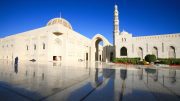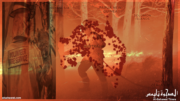Few people are aware their wellbeing may one day depend on the horseshoe crab
Advertisement – Advertise here from OMR 100 / $275 USD
Al-Sahawat Times | Ethical Global News from Oman and UAE | Donate HERE
Advertisement – Advertise here from OMR 100 / $275 USD
Few people are aware their wellbeing may one day depend on theses blue-blooded Horseshoe crabs which are marine and brackish water arthropods of the family Limulidae, suborder Xiphosurida, and order Xiphosura.
Their popular name is actually a misnomer, for they bear little resemblance to horseshoes, and they are not true crabs. Because of their origin 450 million years ago, horseshoe crabs are considered living fossils.
Horseshoe crabs live primarily in and around shallow coastal waters on soft sandy or muddy bottoms. They occasionally come onto shore to mate. They are commonly eaten in Asia, and used as fishing bait and in fertilizer and in science.
Horseshoe crabs use hemocyanin to carry oxygen through their blood. Because of the copper present in hemocyanin, their blood is blue .Thus the horseshoe crab is used by the pharmaceutical industry to make the most sensitive indicator of bacteria ever discovered. The blood is vital to identifying contaminants in medical equipment before surgical operations, pacemaker fittings and many vaccinations.
Such is the demand that processed blood from the crab is now, gram for gram, one of the most valuable liquids on Earth, with a reported price between $35,000 and $60,000 per gallon.
US pharmaceutical companies catch more than 430,000 of these creatures each year, puncture the shell near the heart, harvest 30% of the blood, and then return them to the wild. Studies show that between 5% and 20% die in this process and surviving females find it more difficult to breed.
In recent years, population declines have also occurred as a consequence of coastal habitat destruction and overharvesting. The creation of protected areas and the introduction of bait harvesting limits has helped populations partially recover in some areas, but the harvesting has moved to other areas where there is no restrictions.
For much of this year, fertiliser run-off along the coast of Miami has created vast carpets of algae that suffocate or poison marine life. During these prolonged red tides, biologists, volunteers and fishing captains have reported many dead crabs, including horseshoe crabs of all sizes.
“Presumably the toxins cause stress, and the extremely low levels of oxygen in the water cause the mortality,” said Claire Crowley of the Fish and Wildlife Research Institute. “We have seen this in stone crab population within this area. While stone and horseshoe crabs have the capacity to move, it is likely not fast enough to escape these conditions.”
Scientists predict horseshoe crab numbers off the east coast of the US will decrease by 30% over the coming decades. The fall of its three Asian subspecies is forecast to be even more rapid, because the crabs there are sold for food after the blood is harvested.
Mike Schmidtke of the Atlantic States Marine Fisheries Commission said the main problem for the crabs was the decline in the quality or availability of the beaches they use for spawning.
Critics say regulatory bodies are too closely connected to the pharmaceutical industry, which is hampering efforts to limit catches.
Biomedical companies are also trying captive breeding and the development of a synthetic substitute, but they are yet to win approval for these tests from the US Food and Drug Administration.
Thomas Novitsky of the Horseshoe Crab Conservation Association said lab alternatives would have a negligible impact. Better, he said, was an improvement in harvesting practices, stronger habitat protection and tighter restrictions on the use of the crab as bait.
The biomedical industry, he said, overstated the importance of the lysate, which exploits the horseshoe crabs to monitor drug quality and production cleanliness. “Their profits are enormous and they support little or no conservation efforts,” he said. “Economic growth, profit and immediate ‘benefit’ for humankind always seem to win out over sustainability and environmental protection, which is the insurance for our future.”
Few realise this ancient creature now faces its greatest threat in more than 450m years.
The horseshoe crab outlived the dinosaurs and has survived four previous mass extinctions, but is now menaced by the pharmaceutical industry, fishing communities, habitat loss, climate change and, most recently, choking tides of red algae off the east coast of the United States.
Abundant three decades ago, this living fossil was put on the vulnerable list by the International Union for the Conservation of Nature in 2016. Scientists say the crab’s decline symbolises the huge economic and health costs of biodiversity loss worldwide.
This will be underscored by a UN report this month that will show humanity is running down the natural capital of the Earth at a “startling” rate. Since 1992, More than 30% of the planet’s ecological wealth – the estimated value of species, forests, rivers and soil – has been lost, with profound consequences not just for conservation but for the health and wellbeing of hundreds of millions of people.
“The report has startling findings with strong implication for conservation and development policies,” wrote Pushpam Kumar, the UN chief environmental economist, ahead of the report’s publication.
The danger, he said, is that the world is now destroying natural wealth created over millions of years to generate short-term income.
Despite such warnings, species such as the horseshoe crab are coming under ever-greater pressure. Human longevity is increasingly reliant on medical implants and the risks of septicaemia is growing as microbes become more resistant to antibiotics. That will mean more contamination tests and consequently, more harvesting of blood from horseshoe crabs.
To address this, many wildlife campaigns focus on pandas, tigers and other cute megafauna, but the biggest economic damage is being done to less charismatic species such as insects, worms, plants, fish and crabs.
Since you’re here …
… we have a small favour to ask. More people are reading Al-Sahawat Times than ever but advertising revenues across the global media industry are falling fast. And unlike many news organisations, we haven’t put up a total paywall. We want to keep our journalism as open as we can. So you can see why we need to ask for your help. Al-Sahawat Times’ independent, investigative journalism takes a lot of time, money and hard work to produce. But we do it because we believe truly ethical media and an unbias perspective really matters.
“I appreciate there not being a paywall: it is more democratic for the media to be available for all and not a commodity to be purchased by a few. I’m happy to make a contribution so others with less means still have access to information.”
If everyone who reads our reporting, who likes it, helps fund it, the future of ethical media and the futures of our staff and their families would be much more secure. For as little as £1, you can support Al-Sahawat Times and it only takes a minute. Thank you.
This story is available on:
APPLE NEWS | GOOGLE NEWS | FLIPBOARD | AL-SAHAWAT TIMES
Talk to a journalist
Email: NewsDesk@alsahawat.com
Web: alsahawat.com
Follow Al-Sahawat Times
?Read it on FLIPBOARD
M.AlSaid@alsahawat.com | Journalist
Views: 3






